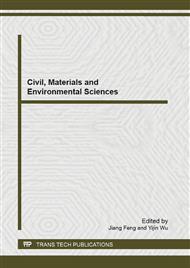p.24
p.30
p.34
p.40
p.46
p.51
p.56
p.62
p.70
The Research on Modified Park-Ang Damage Model Based on Effective Energy Dissipation
Abstract:
Collapse of buildings in earthquakes causes casualties and economic losses, the reinforced concrete columns damage models is a basis for the research of integer collapse. The major advantage of Park and Ang's method is the consideration of first exceedance failure and cumulative damage failure in terms of defining the structural damage under earthquake, however, it isn't consider the differences of structural failures by different displacement amplitudes and load sequence. By multiplying the effective energy dissipation factor and the load sequence factor, the modified Park-Ang seismic damage model is obtained. The comparison between the two models indicates that the modified Park-Ang model have mean value closer to 1 and smaller scatter, besides the effects of load path and load sequence on damage can be taken into account in the modified model.
Info:
Periodical:
Pages:
46-50
Citation:
Online since:
August 2013
Authors:
Price:
Сopyright:
© 2013 Trans Tech Publications Ltd. All Rights Reserved
Share:
Citation:


